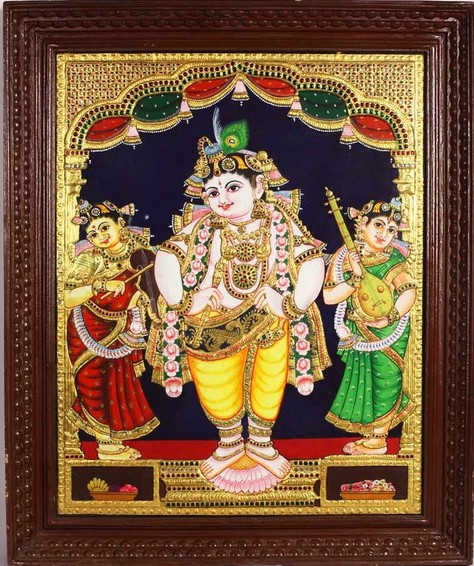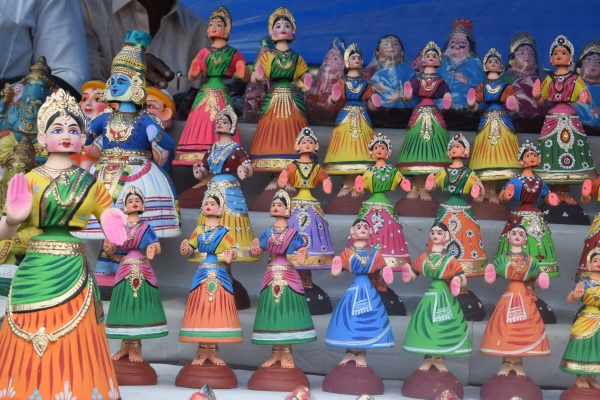Authentic Traditional Crafts Of Thanjavur With Geographical Indication Tag
A religious, cultural and heritage hub, Thanjavur in Tamilnadu has four authentic traditional crafts recognized as Geographical Indication.
When we were posted to Thanjavur, Tamilnadu my first reaction was not very favorable. My apprehensions to move to the place were not unfounded and initial few months in Thanjavur seemed frustrating with sign language conversations and a little-uncomfortable-for-me conservative society.
But since everyone was open to speaking English albeit broken, I gradually developed a way out to carry on my day’s work. With no acquaintances in the neighborhood, it seemed a great idea to explore what the city had to offer.
Thanjavur, a religious small town, turned out to be cultural hub besides being home to the tallest temple built in 1010 AD by Chola Kings, Brihadeswara or Big temple, a UNESCO World Heritage site. I suddenly found myself falling in love with the place because of architectural heritage that was in abundance.
(Also read my post on UNESCO Site of Chola temple Airawateshwar at Darasuram. )
While I indulged in visiting temples, Maratha Palace, Kallanai dam and Saraswati Mahal Library, I also learnt that not one but four traditional crafts of Thanjavur were listed as Geographical Indication.
What is GI or Geographical Indication?
The first GI tag product of India was Darjeeling Tea. Thus no other tea producer from any other part of India or world can use the term ‘Darjeeling Tea’ except those in Darjeeling.
World trade Organization, which India is a member of, defines Geographical Indication (GI) as:
“Indications which identify a good as originating in the territory of a member, or a region or a locality in that territory, where a given quality, reputation or characteristic of the good is essentially attributable to its geographic origin.” (Source: Wikipedia)
In other words, GI is a name or logo used on some products which relate to a specific geographical location like a town, region, or country. This tag ensures that only the location registered for tag uses the popular product name which in turn gives authentication of quality. With GI, imitations can be distinguished from genuine work.
GI Tag for Ancient Traditional Crafts of Thanjavur:
These handicrafts are exclusively made in Thanjavur and nowhere else.
Thanjavur Paintings:
Patronized by Nayak dynasty rulers, Tanjore or Thanjavur painting usually has Hindu Gods and Goddesses as subjects painted on wood plank. The vividly coloured gold leaf, gesso and glass bead inlay art work in its current form originated in 1676 when Marathas were in power. The art though takes inspiration from painting style during Nayaka rulers and is influenced from the styles of Deccan, Folk, Telugu and even European.

Tanjore painting (source Poompuhar)
With Hindu Gods and goddesses as primary subjects, the ‘palagai padam’ or wood plank paintings were recognized GI in 2007-8.
Thanjavur Dancing Clay Dolls
The first time I saw Bommai Kolu, a display of dancing dolls, was at a restaurant at Chennai Airport. Unaware of the festive significance, I was mildly surprised. Later at Thanjavur, I noticed the brightly colored dolls on every makeshift stall. The occasion was Dassehra when these terracotta dolls known as ‘Thalaiatti Bommai’ are put up in a tiered display often telling a mythological story.
The dolls made of terracota and papier mache are traditional bobbleheads with a head that oscillates in rhythmic motion. Most dolls are detachable at head, bust and bottom. These are painstakingly made with clay, chalk powder and paper pulp. The dolls are painted in bright colors and are often sold in pairs with the pair of an old pot-bellied man and old woman being quite popular.
Come festival of Navratri and Dasara, the city is flooded with various sizes of these dolls
The dolls recognized GI in 2008-2009 were patronized by the Maratha King Serfoji Maharaj in early 19th century and tradition has been kept alive by the local artisans.

Dancing Clay Dolls
Thanjavur Veena
Revered for its resonant quality, the Saraswati Veena is a Carnatic musician’s prized possession. Dating back to 1700 BC, the current form was patronized by Raghunath Nayak of the Nayak dynasty.

Veena instruments in various stages of making.
Recognized as GI in 2013, each Veena, made from wood of mature jackfruit tree, takes two to three months for completion with the artisan chipping away patiently with precision. The bulb of the instrument is intricately carved with floral motifs or image of Goddess Saraswati before being wax polished for a gleaming finish.
Also read my post on hand-crafted Saraswati Veena of Thanjavur.
Thanjavur Art Plate
Another art specially crafted as a gift at the suggestion of the Maratha ruler Serfoji II was decorative metal plate that came to be GI tagged in 1999. Handcrafted with silver, brass, bronze and copper, the plate has figures of Gods and goddesses embossed on its center and floral motifs on the base plates.

Thanjavur Art Plate (Image source: Poompuhar)
The craft of metal plate exclusively made by goldsmiths and jewelers of Vishwakarma community is handed down to generations. An intriguing fact was that the community gave the privilege of crafting these plates only to men.
The brass is used to make the base of plate and silver is used in the relief work with embossed designs. While the artisans that work with heavy metals make the base and wax boards for the plate, the rather delicate embossing on silver is done by jewelers.
With the ancient crafts still continuing the tradition, Thanjavur is where the people are connected to their roots.
Where to Buy Handicrafts?
- Street opposite the Maratha Palace has many shops selling Tanjore paintings.
- Poompahar is the most popular retailer for all kinds of handicrafts.
- South Main Street of Thanjavur for Saraswati veena.


Wow! So much information with so much of efficiency. What I liked most about the post is the wise use of words to bring out the exact meaning intended.
Loved the post for its writing and its tour to the arty part of Thanjavur.
LikeLiked by 1 person
Thank you Neeraj for such encouraging comments. Thanjavur though a very small town has so much of tangible and intangible heritage to absorb. It must be on travel wishlist.
LikeLike
Very informative post on Thanjavur traditional crafts with beautiful captures,did not have much knowledge about GI though have taken Darjeeling tea several times.
LikeLiked by 1 person
Thank you Jyotirmay. I myself was not aware of GI until I saw these handicrafts and talked to craftsmen.
LikeLiked by 1 person
this is such informative post on traditional crafts of thanjavur. I have never heard about any of this.Thank you shoma sharing this article
LikeLiked by 1 person
Thank you Mayuri. I had known about Thanjavur paintings but came to know about others after visiting the veena makers in Thanjavur. It sure is a heritage to be proud of and conserve.
LikeLike
Thanjavur proves that India is truly a country of immense talent and skill since ancient times. We all should try and promote this for of art far and wide.
LikeLiked by 1 person
Well said Shivani. We should take pride in our heritage and traditional crafts along with telling the world about those.
LikeLike